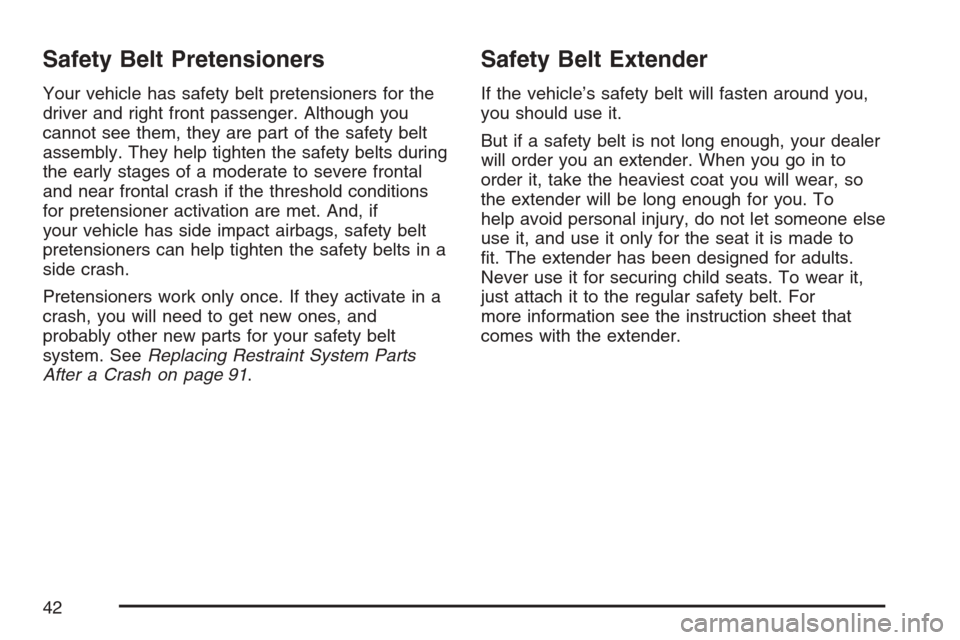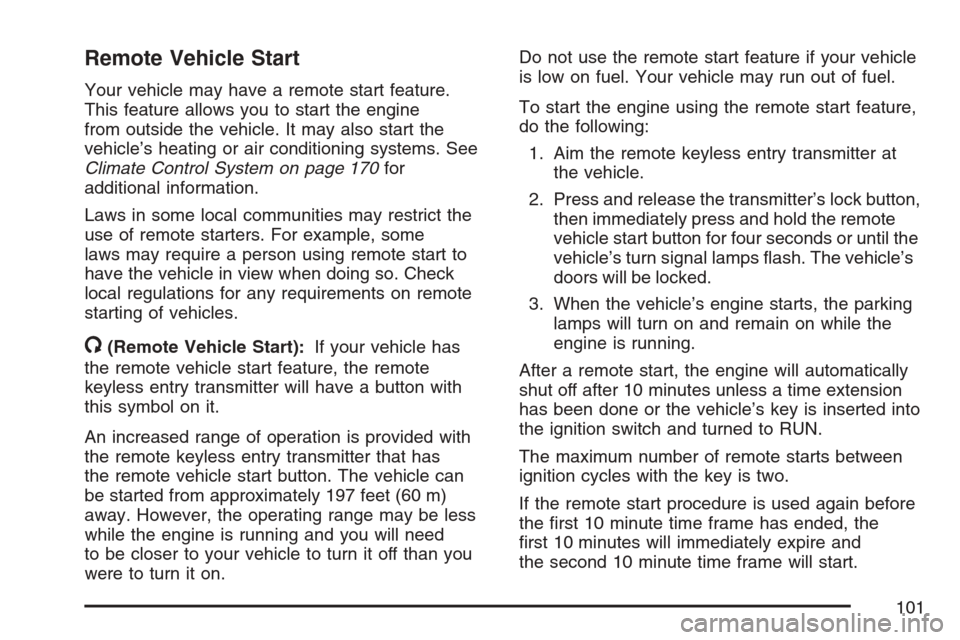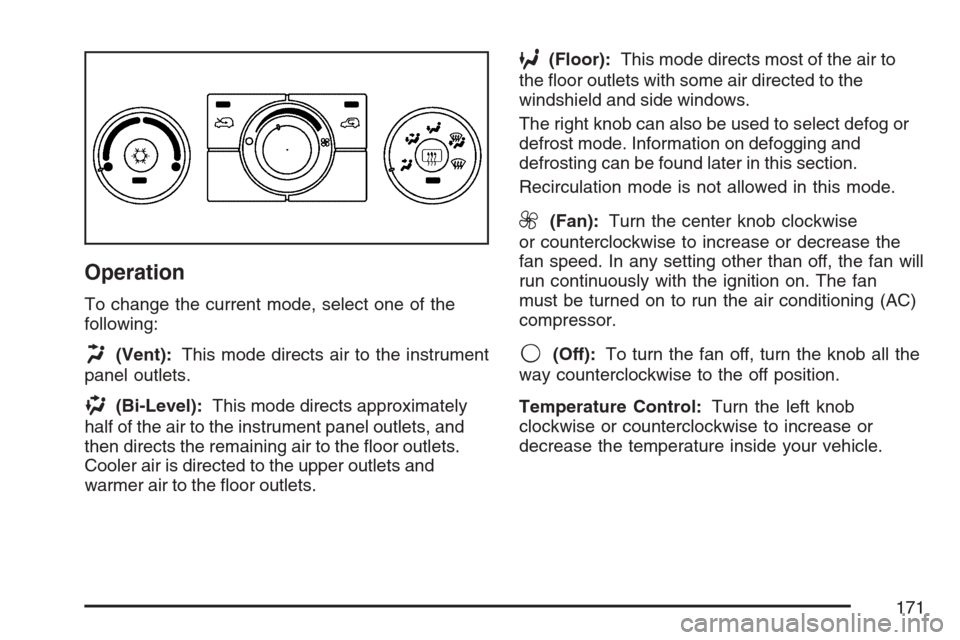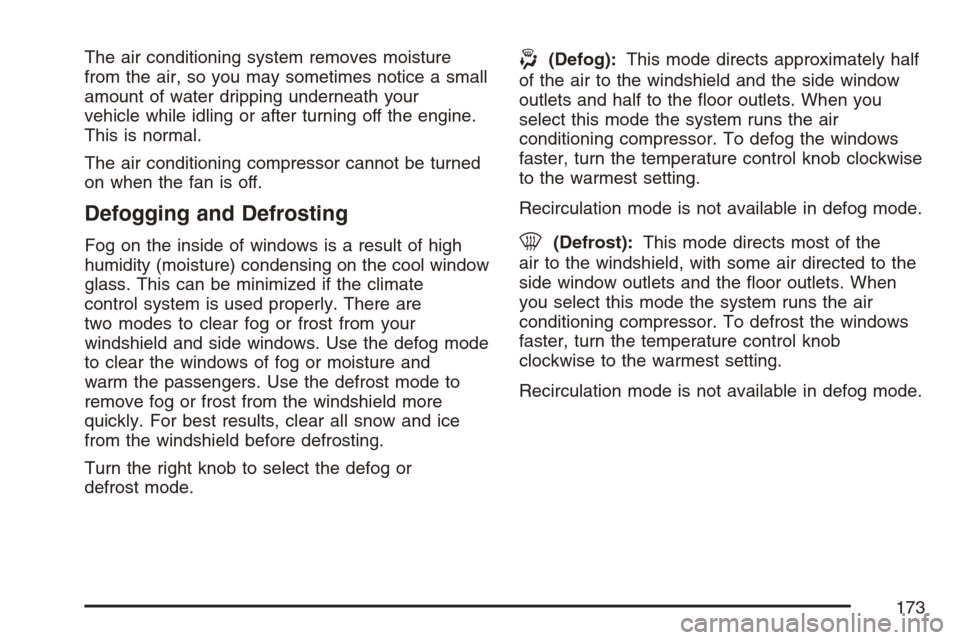2007 CHEVROLET HHR air condition
[x] Cancel search: air conditionPage 42 of 446

Safety Belt Pretensioners
Your vehicle has safety belt pretensioners for the
driver and right front passenger. Although you
cannot see them, they are part of the safety belt
assembly. They help tighten the safety belts during
the early stages of a moderate to severe frontal
and near frontal crash if the threshold conditions
for pretensioner activation are met. And, if
your vehicle has side impact airbags, safety belt
pretensioners can help tighten the safety belts in a
side crash.
Pretensioners work only once. If they activate in a
crash, you will need to get new ones, and
probably other new parts for your safety belt
system. SeeReplacing Restraint System Parts
After a Crash on page 91.
Safety Belt Extender
If the vehicle’s safety belt will fasten around you,
you should use it.
But if a safety belt is not long enough, your dealer
will order you an extender. When you go in to
order it, take the heaviest coat you will wear, so
the extender will be long enough for you. To
help avoid personal injury, do not let someone else
use it, and use it only for the seat it is made to
�t. The extender has been designed for adults.
Never use it for securing child seats. To wear it,
just attach it to the regular safety belt. For
more information see the instruction sheet that
comes with the extender.
42
Page 82 of 446

Passenger Sensing System
Your vehicle has a passenger sensing system for
the right front passenger’s position. A passenger
airbag status indicator on the instrument panel will
be visible when you turn your ignition key to
START or RUN.
The words ON and OFF or the symbol for on and
off, will be visible during the system check. If
you are using remote start to start your vehicle
from a distance, you may not see the system
check. When the system check is complete, either
the word ON or the word OFF, or the symbol
for on or the symbol for off will be visible.
SeePassenger Airbag Status Indicator on
page 182.The passenger sensing system will turn off the
right front passenger’s frontal airbag under certain
conditions. The driver’s airbags are not part of
the passenger sensing system.
The passenger sensing system works with
sensors that are part of the right front passenger’s
seat and safety belt. The sensors are designed
to detect the presence of a properly-seated
occupant and determine if the passenger’s frontal
airbag should be enabled (may in�ate) or not.
Accident statistics show that children are safer if
they are restrained in the rear rather than the front
seat. We recommend that child restraints be
secured in a rear seat, including an infant riding in
a rear-facing infant seat, a child riding in a
forward-facing child seat and an older child riding
in a booster seat.
United StatesCanada
82
Page 101 of 446

Remote Vehicle Start
Your vehicle may have a remote start feature.
This feature allows you to start the engine
from outside the vehicle. It may also start the
vehicle’s heating or air conditioning systems. See
Climate Control System on page 170for
additional information.
Laws in some local communities may restrict the
use of remote starters. For example, some
laws may require a person using remote start to
have the vehicle in view when doing so. Check
local regulations for any requirements on remote
starting of vehicles.
/(Remote Vehicle Start):If your vehicle has
the remote vehicle start feature, the remote
keyless entry transmitter will have a button with
this symbol on it.
An increased range of operation is provided with
the remote keyless entry transmitter that has
the remote vehicle start button. The vehicle can
be started from approximately 197 feet (60 m)
away. However, the operating range may be less
while the engine is running and you will need
to be closer to your vehicle to turn it off than you
were to turn it on.Do not use the remote start feature if your vehicle
is low on fuel. Your vehicle may run out of fuel.
To start the engine using the remote start feature,
do the following:
1. Aim the remote keyless entry transmitter at
the vehicle.
2. Press and release the transmitter’s lock button,
then immediately press and hold the remote
vehicle start button for four seconds or until the
vehicle’s turn signal lamps �ash. The vehicle’s
doors will be locked.
3. When the vehicle’s engine starts, the parking
lamps will turn on and remain on while the
engine is running.
After a remote start, the engine will automatically
shut off after 10 minutes unless a time extension
has been done or the vehicle’s key is inserted into
the ignition switch and turned to RUN.
The maximum number of remote starts between
ignition cycles with the key is two.
If the remote start procedure is used again before
the �rst 10 minute time frame has ended, the
�rst 10 minutes will immediately expire and
the second 10 minute time frame will start.
101
Page 124 of 446

NEUTRAL (N):In this position, your engine does
not connect with the wheels. To restart when
you are already moving, use NEUTRAL (N) only.
Also, use NEUTRAL (N) when your vehicle is
being towed.
{CAUTION:
Shifting into a drive gear while your
engine is running at high speed is
dangerous. Unless your foot is �rmly on
the brake pedal, your vehicle could move
very rapidly. You could lose control and
hit people or objects. Do not shift into a
drive gear while your engine is running at
high speed.Notice:Shifting out of PARK (P) or
NEUTRAL (N) while the engine is running at
high speed may damage the transaxle.
The repairs would not be covered by your
warranty. Be sure the engine is not running at
high speeds when shifting your vehicle.
DRIVE (D):This position is for normal driving with
the automatic transaxle. It provides the best fuel
economy for your vehicle. If you need more power
for passing, and you are:
Going less than about 35 mph (55 km/h), push
your accelerator pedal about halfway down.
Going about 35 mph (55 km/h), push
your accelerator all the way down.
Downshifting the transaxle in slippery road
conditions could result in skidding, see “Skidding”
underLoss of Control on page 253.
124
Page 139 of 446

OnStar®System
OnStar®uses several innovative technologies and
live advisors to provide you with a wide range
of safety, security, information, and convenience
services. If your airbags deploy, the system is
designed to make an automatic call to OnStar
®
Emergency advisors who can request emergency
services be sent to your location. If you lock
your keys in the vehicle, call OnStar
®at
1-888-4-ONSTAR and they can send a signal to
unlock your doors. If you need roadside
assistance, press the OnStar
®button and they
can contact Roadside Service for you.OnStar
®service is provided to you subject to the
OnStar®Terms and Conditions. You may cancel
your OnStar®service at any time by contacting
OnStar®as provided below. A complete OnStar®
Owners Guide and the OnStar®Terms and
Conditions are included in the vehicle’s OnStar®
Subscriber glove box literature. For more
information, visit onstar.com or onstar.ca, contact
OnStar
®at 1-888-4-ONSTAR (1-888-466-7827) or
TTY 1-877-248-2080, or press the OnStar®button
to speak with an OnStar®advisor 24 hours a day,
7 days a week.
Not all OnStar
®features are available on all
vehicles. To check if your vehicle is equipped to
provide the services described below, or for a
full description of OnStar
®services and system
limitations, see the OnStar®Owner’s Guide in your
glove box or visit onstar.com.
139
Page 171 of 446

Operation
To change the current mode, select one of the
following:
H(Vent):This mode directs air to the instrument
panel outlets.
)(Bi-Level):This mode directs approximately
half of the air to the instrument panel outlets, and
then directs the remaining air to the �oor outlets.
Cooler air is directed to the upper outlets and
warmer air to the �oor outlets.
6(Floor):This mode directs most of the air to
the �oor outlets with some air directed to the
windshield and side windows.
The right knob can also be used to select defog or
defrost mode. Information on defogging and
defrosting can be found later in this section.
Recirculation mode is not allowed in this mode.
9(Fan):Turn the center knob clockwise
or counterclockwise to increase or decrease the
fan speed. In any setting other than off, the fan will
run continuously with the ignition on. The fan
must be turned on to run the air conditioning (AC)
compressor.
9(Off):To turn the fan off, turn the knob all the
way counterclockwise to the off position.
Temperature Control:Turn the left knob
clockwise or counterclockwise to increase or
decrease the temperature inside your vehicle.
171
Page 172 of 446

@(Recirculate):Press this button to prevent
outside air and odors from entering your vehicle or
to help heat or cool the air inside your vehicle
more quickly. An indicator light above the symbol
will come on in this mode. The air conditioning
compressor also comes on. This mode is not
available for �oor, defog and defrost modes. When
the recirculation button is pressed, the recirculation
indicator light will �ash �ve times and outside
air will be delivered. Operation in this mode during
periods of high humidity and cool outside
temperatures may result in increased window
fogging. If window fogging is experienced, select
the defrost mode.
;(Outside Air):Press this button to allow
outside air to circulate through your vehicle.
An indicator light above the symbol will come on
in this mode.
#(Air Conditioning):Press this button to turn
the air conditioning system on or off. When
this button is pressed, an indicator light below the
symbol will come on to let you know the air
conditioning is activated.
On hot days, open the windows to let hot inside
air escape; then close them. This helps to reduce
the time it takes for your vehicle to cool down.
It also helps the system to operate more efficiently.
For quick cool down on hot days:
1. Select the vent mode.
2. Select the recirculation mode.
3. Select air conditioning.
4. Select the coolest temperature.
5. Select the highest fan speed.
Using these settings together for long periods of
time may cause the air inside of your vehicle
to become too dry. To prevent this from
happening, after the air in your vehicle has cooled,
turn off the recirculation by pressing the outside
air button.
172
Page 173 of 446

The air conditioning system removes moisture
from the air, so you may sometimes notice a small
amount of water dripping underneath your
vehicle while idling or after turning off the engine.
This is normal.
The air conditioning compressor cannot be turned
on when the fan is off.
Defogging and Defrosting
Fog on the inside of windows is a result of high
humidity (moisture) condensing on the cool window
glass. This can be minimized if the climate
control system is used properly. There are
two modes to clear fog or frost from your
windshield and side windows. Use the defog mode
to clear the windows of fog or moisture and
warm the passengers. Use the defrost mode to
remove fog or frost from the windshield more
quickly. For best results, clear all snow and ice
from the windshield before defrosting.
Turn the right knob to select the defog or
defrost mode.
-(Defog):This mode directs approximately half
of the air to the windshield and the side window
outlets and half to the �oor outlets. When you
select this mode the system runs the air
conditioning compressor. To defog the windows
faster, turn the temperature control knob clockwise
to the warmest setting.
Recirculation mode is not available in defog mode.
0(Defrost):This mode directs most of the
air to the windshield, with some air directed to the
side window outlets and the �oor outlets. When
you select this mode the system runs the air
conditioning compressor. To defrost the windows
faster, turn the temperature control knob
clockwise to the warmest setting.
Recirculation mode is not available in defog mode.
173